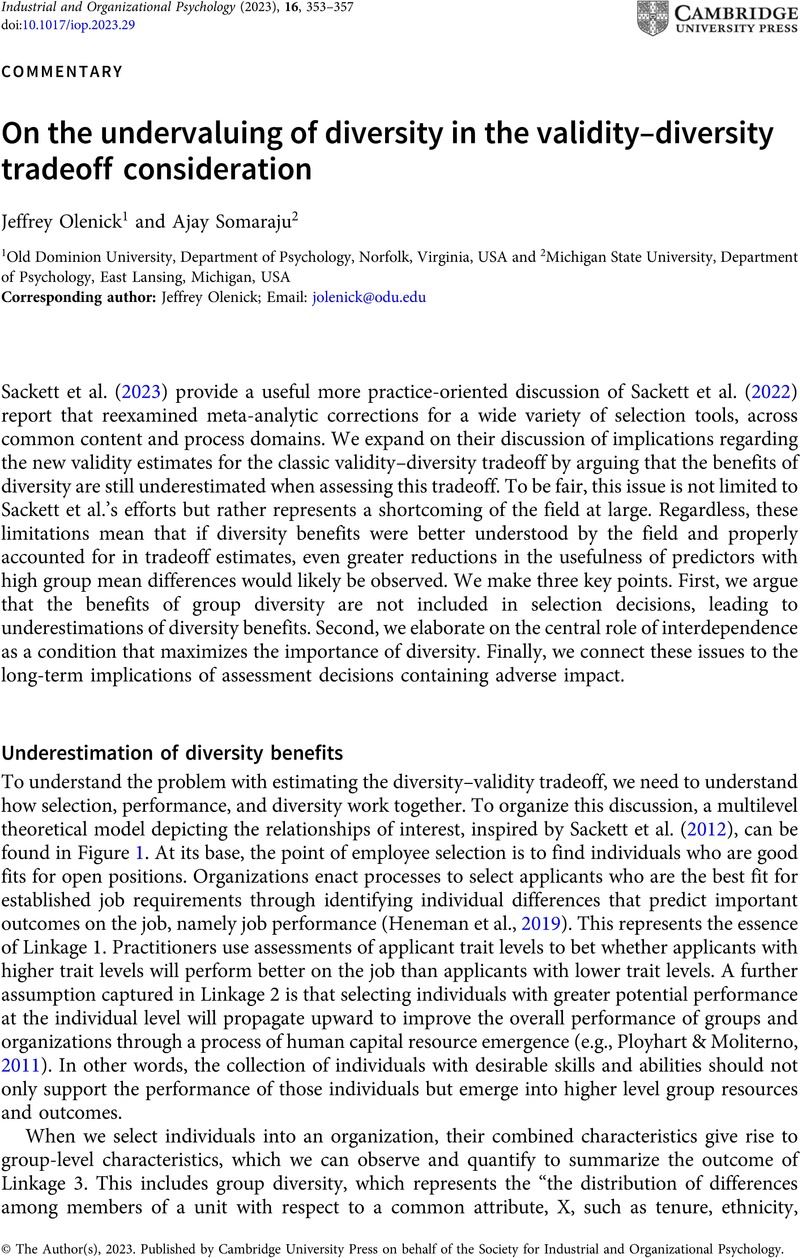No CrossRef data available.
Article contents
On the undervaluing of diversity in the validity–diversity tradeoff consideration
Published online by Cambridge University Press: 31 August 2023
Abstract
An abstract is not available for this content so a preview has been provided. Please use the Get access link above for information on how to access this content.

- Type
- Commentaries
- Information
- Copyright
- © The Author(s), 2023. Published by Cambridge University Press on behalf of the Society for Industrial and Organizational Psychology
References
Amis, J. M., Mair, J., & Munir, K. A. (2020). The organizational reproduction of inequality. Academy of Management Annals, 14(1), 195–230. https://doi.org/10.5465/annals.2017.0033
CrossRefGoogle Scholar
Bell, B. S., & Kozlowski, S. W. J. (2002). A typology of virtual teams: Implications for effective leadership. Group & Organization Management, 27(1), 14–49. https://doi.org/10.1177/1059601102027001003
CrossRefGoogle Scholar
De Corte, W., Lievens, F., & Sackett, P. R. (2007). Combining predictors to achieve optimal trade-offs between selection quality and adverse impact. Journal of Applied Psychology, 92, 1380–1393. https://doi.org/10.1037/0021-9010.92.5.1380
CrossRefGoogle ScholarPubMed
De Corte, W., Sackett, P. R., & Lievens, F. (2020). Robustness, sensitivity, and sampling variability of Pareto-optimal selection system solutions to address the quality-diversity trade-off. Organizational Research Methods, 22(3), 535–568. https://doi.org/10.1177/1094428118825301
CrossRefGoogle Scholar
Derenoncourt, E., Kim, C. H., Kuhn, M., & Schularick, M. (2022). Wealth of two nations: The U.S. racial wealth gap, 1860-2020 (Working Paper No. 30101; Working Paper Series). National Bureau of Economic Research. https://doi.org/10.3386/w30101
CrossRefGoogle Scholar
Griffin, D. J., Somaraju, A. V., Dishop, C., & DeShon, R. P. (2022). Evaluating interdependence in workgroups: A network-based method. Organizational Research Methods. Advance online publication. https://doi.org/10.1177/10944281211068179
Google Scholar
Harrison, D. A., & Klein, K. J. (2007). What’s the difference? Diversity constructs as separation, variety, or disparity in organizations. Academy of Management Review, 32(4), 1199–1228. https://doi.org/10.5465/amr.2007.26586096
CrossRefGoogle Scholar
Heneman, H. G., Judge, T. A., & Kammeyer-Mueller, J. D. (2019). Staffing organizations (9th ed.). McGraw-Hill.Google Scholar
Joshi, A., & Roh, H. (2009). The role of context in work team diversity research: A meta-analytic review. Academy of Management Journal, 52(3), 599–627. https://doi.org/10.5465/amj.2009.41331491
CrossRefGoogle Scholar
Martins, L. L., & Sohn, W. (2022). How does diversity affect team cognitive processes? Understanding the cognitive pathways underlying the diversity dividend in teams. Academy of Management Annals, 16(1), 134–178. https://doi.org/10.5465/annals.2019.0109
CrossRefGoogle Scholar
Mohammed, S., & McKay, A. S. (2017). Selection for team membership: Complexity, contingency, and dynamism across multiple levels. In Farr, J. L. & Tippins, N. T. (Eds.), Handbook of employee selection (2nd ed., pp. 812–832). Routledge. https://www.routledgehandbooks.com/doi/10.4324/9781315690193-37
CrossRefGoogle Scholar
Olenick, J., Ryan, A. M., & Kuljanin, G. (2021). Basic incomes and the dynamics of wealth accumulation, individual development, and employment opportunities. Industrial and Organizational Psychology, 14(4), 563–568. https://doi.org/10.1017/iop.2021.107
CrossRefGoogle Scholar
Ployhart, R. E., & Moliterno, T. P. (2011). Emergence of the human capital resource: A multilevel model. Academy of Management Review, 36(1), 127–150. https://doi.org/10.5465/amr.2009.0318
CrossRefGoogle Scholar
Pyburn, K. M. Jr., Ployhart, R. E., & Kravitz, D. A. (2008). The diversity-validity dilemma: Overview and legal context. Personnel Psychology, 61(1), 143–151. https://doi.org/10.1111/j.1744-6570.2008.00108.x
CrossRefGoogle Scholar
Ray, V. (2019). A theory of racialized organizations. American Sociological Review, 84(1), 26–53. https://doi.org/10.1177/0003122418822335
CrossRefGoogle Scholar
Sackett, P. R. (2005). The performance-diversity tradeoff in admission testing. In Camara, W. J. & Kimmel, E. W. (Eds.), Choosing students: Higher education admissions tools for the 21st century (pp. 109–125). Lawrence Erlbaum Associates
Google Scholar
Sackett, P. R., Putka, D. J., & McCloy, R. A. (2012). The concept of validity and the process of validation. In Kozlowski, S. W. J. (Ed.), The Oxford handbook of organizational psychology (pp. 91–118). Oxford University Press.Google Scholar
Sackett, P. R., Zhang, C., & Berry, C. M. (2023). Challenging conclusions about predictive bias against Hispanic test takers in personnel selection. Journal of Applied Psychology, 108, 341–349. https://doi.org/10.1037/apl0000978
CrossRefGoogle ScholarPubMed
Sackett, P. R., Zhang, C., Berry, C. M., & Lievens, F. (2022). Revisiting meta-analytic estimates of validity in personnel selection: Addressing systematic overcorrection for restriction of range. Journal of Applied Psychology, 107, 2040–2068. https://doi.org/10.1037/apl0000994
CrossRefGoogle ScholarPubMed
Somaraju, A. V., & Olenick, J. (2022). When equality causes inequity: A note on widening wealth disparities in equal selection systems. PsyArXiv Preprints. https://doi.org/10.31234/osf.io/ng2y5
CrossRefGoogle Scholar




